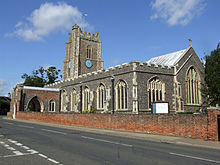St Peter and St Paul's Church, Aldeburgh
| St Peter and St Paul's Church, Aldeburgh | |
|---|---|
 St Peter and St Paul's Church, Aldeburgh | |
 | |
| 52°09′18″N 1°36′00″E / 52.154952°N 1.5999055°E | |
| Location | Aldeburgh |
| Country | England |
| Denomination | Church of England |
| History | |
| Dedication | St Peter and St Paul |
| Architecture | |
| Heritage designation | Grade II* listed |
| Administration | |
| Province | Province of Canterbury |
| Diocese | Diocese of St Edmundsbury and Ipswich |
| Archdeaconry | Archdeaconry of Suffolk |
| Deanery | Saxmundham |
| Parish | Aldeburgh with Hazlewood |
St Peter and St Paul's Church, Aldeburgh is a Grade II* listed parish church in the Church of England[1] in Aldeburgh, Suffolk.
History
[edit]The church tower dates from the 14th century, but much of the rest is 16th century, including the nave, north aisle and north chapel of 1525–1529; the south aisle and chapel 1534–1535; the south porch of 1539 and the chancel 1545. It was restored between 1870 and 1871 by Henry Perkin and again in 1891 by EF Bishop.
Bells
[edit]The church has a ring of eight bells, with all but the sixth bell being cast by John Taylor & Co at their Loughborough foundry in 1960 and 1961 as part of the restoration and augmentation of the ring. The restored bells were rededicated on 18 June 1961. Previously there were six bells, which were rehung by George Day of Eye in 1885, with fourth bell recast and treble added by John Warner & Sons to make six. The bells hang in an iroko wooden frame installed at the same time as the bells were overhauled in the 1960s.[2]
Peals lasting around three hours are rung on the bells most months by members of the Suffolk Guild of Ringers. In 2008 a complaint was lodged with Suffolk Coastal district council by a neighbour.[3] The complaint was not upheld and dismissed during a debate in the House of Commons.[4]
| Bell | Date | Note | Diameter | Founder | Weight | ||
|---|---|---|---|---|---|---|---|
| long measure | lb | kg | |||||
| Treble | 1961 | Ab | 23.50 in (59.7 cm) | John Taylor & Co | 3 long cwt 0 qr 20 lb | 356 | 161 |
| 2nd | 1961 | G | 24.50 in (62.2 cm) | John Taylor & Co | 3 long cwt 1 qr 25 lb | 389 | 176 |
| 3rd | 1960 | F | 26.00 in (66.0 cm) | John Taylor & Co | 3 long cwt 3 qr 21 lb | 441 | 200 |
| 4th | 1960 | Eb | 27.50 in (69.9 cm) | John Taylor & Co | 4 long cwt 2 qr 2 lb | 506 | 230 |
| 5th | 1622 | Db | 28.50 in (72.4 cm) | William & John II Brend | 4 long cwt 1 qr 7 lb | 483 | 219 |
| 6th | 1913 | C | 31.13 in (79.1 cm) | John Taylor & Co | 6 long cwt 0 qr 4 lb | 676 | 307 |
| 7th | 1913 | Bb | 35.00 in (88.9 cm) | John Taylor & Co | 8 long cwt 2 qr 1 lb | 953 | 432 |
| Tenor | 1960 | Ab | 39.13 in (99.4 cm) | John Taylor & Co | 11 long cwt 2 qr 20 lb | 1,308 | 593 |
Memorials
[edit]There is a memorial by Thomas Thurlow to poet George Crabbe (died 1832) and a monument to Lady Henrietta Vernon (died 1786). The church is most famous as being the burial place of the composer Benjamin Britten and his partner, the tenor Peter Pears; also buried in the churchyard are the pioneering doctor Elizabeth Garrett Anderson, the soprano Joan Cross and the composer and conductor Imogen Holst. Britten is also commemorated in a stained glass window by John Piper and Patrick Reyntiens. The church also houses a memorial to Newson Garrett and his wife, the parents of Elizabeth Garrett Anderson.
-
Grave of Benjamin Britten
-
Adjoining grave of Sir Peter Pears
Organ
[edit]The church has a two manual pipe organ by J. W. Walker & Sons Ltd dating from 1884. A specification of the organ can be found on the National Pipe Organ Register.[6]
References
[edit]- ^ The Buildings of England: Suffolk: Nikolaus Pevsner.
- ^ "ANOTHER OCTAVE IN SUFFOLK" (PDF). Ringing World. 1961: 455.
- ^ Clout, Laura (13 June 2008). "Church bells are a nuisance, say locals". ISSN 0307-1235. Retrieved 31 August 2020.
- ^ "Bell Ringing - Hansard". hansard.parliament.uk. Retrieved 31 August 2020.
- ^ "Dove Details". dove.cccbr.org.uk. Retrieved 31 August 2020.
- ^ "The National Pipe Organ Register - NPOR". www.npor.org.uk. Retrieved 8 March 2021.


